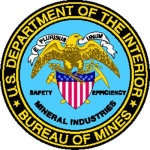- Отрасли: Mining
- Number of terms: 33118
- Number of blossaries: 0
- Company Profile:
The U.S. Bureau of Mines (USBM) was the primary United States Government agency conducting scientific research and disseminating information on the extraction, processing, use, and conservation of mineral resources.
Founded on May 16, 1910, through the Organic Act (Public Law 179), USBM's missions ...
A group of dark-colored, basic intrusive igneous rocks composed principally of basic plagioclase (commonly labradorite or bytownite) and clinopyroxene (augite), with or without olivine and orthopyroxene; also, any member of that group. It is the approximate intrusive equivalent of basalt. Apatite and magnetite or ilmenite are common accessory minerals.
Industry:Mining
A group of dark-colored, porphyritic, hypabyssal igneous rocks characterized by panidiomorphic texture, a high percentage of mafic minerals (esp. biotite, hornblende, and pyroxene), which form the phenocrysts, and a fine-grained groundmass with the same mafic minerals in addition to feldspars and/or feldspathoids; also, any rock in that group. Most lamprophyres are highly altered. They are commonly associated with carbonatites. Compare: leucophyre.
Industry:Mining
A group of dikes, which may be in radial, parallel, or en echelon arrangement. Their relationship with the parent plutonic body may not be directly observable. Compare: dike set.
Industry:Mining
A group of extrusive igneous rocks, typically porphyritic and commonly exhibiting flow texture, with phenocrysts of quartz and alkali feldspar in a glassy to cryptocrystalline groundmass; also, any rock in that group; the extrusive equivalent of granite. Rhyolite grades into rhyodacite with decreasing alkali feldspar content and into trachyte with a decrease in quartz. The term was coined in 1860 by Baron von Richthofen (grandfather of the World War I aviator). Etymol: Greek rhyo-, from rhyax, stream of lava.
Industry:Mining
A group of extrusive rocks, of basaltic character, primarily composed of calcic plagioclase, augite, and nepheline or leucite as the main feldspathoids, with accessory alkali feldspar; also, any member of that group; the extrusive equivalent of theralite. With the addition of olivine, the rock would be called a basanite.
Industry:Mining
A group of faults that are parallel, or nearly so, and that are related to a particular deformational episode. Compare: fault system.
Industry:Mining
A group of ferromagnesian minerals in igneous rock, from a few inches to a foot or more in size, commonly drawn out longitudinally, that may be a segregation or an altered xenolith.
Industry:Mining
A group of fine-grained, generally porphyritic, extrusive rocks having alkali feldspar and minor mafic minerals (biotite, hornblende, or pyroxene) as the main components, and possibly a small amount of sodic plagioclase; also, any member of that group; the extrusive equivalent of syenite. Trachyte grades into latite as the alkali feldspar content decreases, and into rhyolite with an increase in quartz. Etymol: Greek trachys, rough, in reference to the fact that rocks of this group are commonly rough to the touch.
Industry:Mining
A group of fissures of the same age and of more or less parallel strike and dip.
Industry:Mining
A group of flotation cells in which a product from the primary cells is retreated.
Industry:Mining
